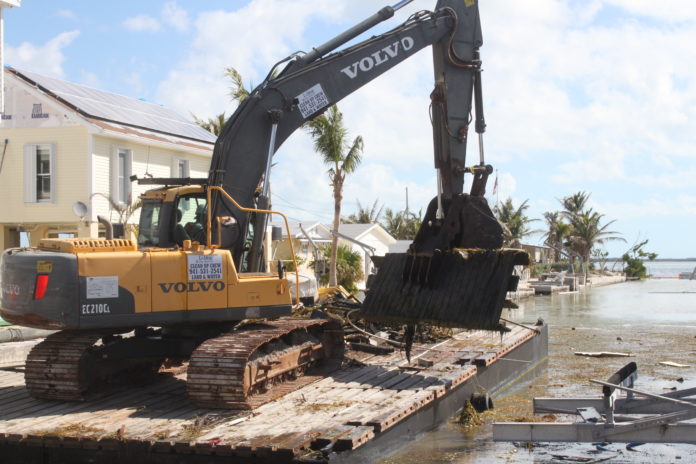“What we’re doing here is cherry-picking. We’re going after the biggest and most obvious first,” said Monroe County Administrator Roman Gastesi.
Today, 206 days after Hurricane Irma swept the Keys, work finally begins on cleaning up the canals choked with hurricane debris on Avenue I on Big Pine Key.
“It’s good to see,” said resident Tim Caraftis, who lives on Avenue D. He was leaning up against the side of a gray pickup truck, watching the crew work as they hauled out planter boxes, lattice and pieces of dock. Two barges had been fitted together to support the knuckle boom loader and the debris it was hauling out of the water. “I’ve already done quite a bit of cleanup on my canal myself, but there’s still big stuff in there to get out — a boat hoist, an engine, trees and tree stumps.”
On Feb. 7, Monroe County officials inked a $6 million dollar deal to begin the clean up in unincorporated Monroe County. The work under this contract is expected to take up to six months and Gastesi said he believes two crews will work seven days a week, although more may be added. Monitors are assigned to make sure wildlife, such as manatees, are not harmed during the process. There is no particular order assigned to the work yet.
An additional $2 million each is coming to the Village of Islamorada and the City of Marathon. Items from boats to refrigerators are submerged, or partially submerged, in about 250 canals in Monroe County. For Islamorada, the most heavily affected area is on Lower Matecumbe Key. In Marathon, it’s the Key By the Sea trailer park where many mobile homes were swept into the canal. Both municipalities have yet to sign MOU’s — memos of understanding — with state officials so work can begin.
The state Department of Environmental Project is the lead agency, and has hired the DRC Emergency Services contractor to work with local coordination. The county and cities are expected to reimburse the state within two years, and the county is in charge of seeking reimbursement from FEMA.
In total, Marathon has 17 canals classified with high or medium impact. Debris retrieved from the water will be moved to two land-based sites in Marathon. The county has identified the site of the former Big Pine Key prison to handle debris once it’s removed from the water.
Officials are looking for canalside lots, however, where the debris can be loaded into trucks headed toward the main debris collection sites. Officials will need approval from the property owners.
“It would be a lot easier and faster to move the debris out of the canal to a lot right there, rather than barging it around,” said Marathon Deputy City Manager George Garrett. The county and Islamorada have said they will also seek similar arrangements.
Islamorada has fewer affected canals, said Councilman Mike Forster. “We do have a couple of instances where sand deposited at the mouth of the canal. That impedes navigation just as much as a sunken boat,” he said. He said he hopes to be able to remove the sand, sift it, and put it back on Sea Oats Beach with the proper approval.
Officials report that in the months since the hurricane, most of the persistent debris has floated on the tide to the mouth of the canals. Assessments are still being conducted and sonar technology will come into use. When asked whether that would be required on every canal, County Sustainability Program Manager Rhonda Haag said the county would follow FEMA guidelines regarding navigational hazards.
In unincorporated Monroe County, an estimated 87 canals fall into the high or medium impact categories. The county reports there is approximately 100,000 cubic yards of debris to be removed from canals in all of the Florida Keys. That’s compared to the 2.5 million cubic yards of landside storm debris already removed from the islands.
Gastesi said this is just the beginning of canal cleanup. The county estimates it will cost between $15 million and $30 million and take three or four years to recover from Hurricane Irma. He spoke of securing extra grants from state and federal agencies such as the Department of Agriculture, the National Oceanic and Atmospheric Administration and others.
The canal on Big Pine Key where the crews started on Feb. 16 was, ironically, the focus of a $1 million restoration project. Prior to Hurricane Irma, the canal labeled No. 280 had been restored to the proper depth and had an air curtain installed at the mouth.

























